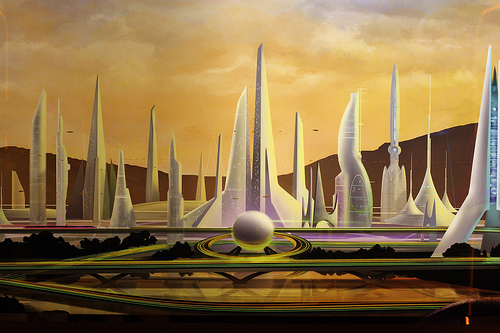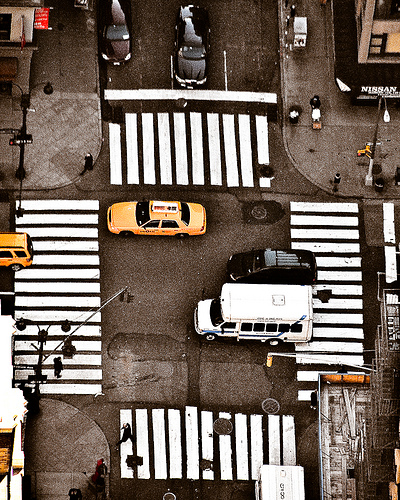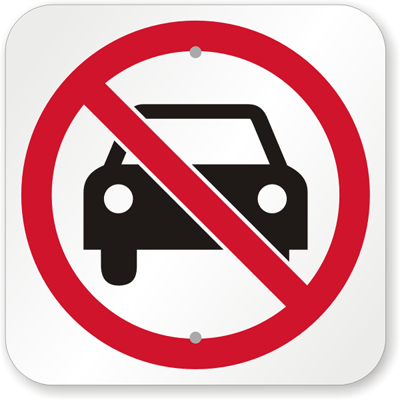The car-free city: wave of the future?
Will cars have a place in the cities of the future? Not if today’s urban planners have much to say about it, according to Fortune. Future urban design will not likely revolve around accommodating cars and drivers, as it did in the past, according to experts at a seminar called “Smart Cities,” held at Fortune‘s Brainstorm Green conference in California last week. Instead, planners will focus on reducing negative environmental impact and addressing the needs of city dwellers that rely on walking, biking and public transit to get around – in other words, if the city of the future isn’t car-free, it’ll be close.

According to this Disney mural, the city of the future won’t have cars, only streaky neon lines… and blimps? From Sam Howzit.
“Smart Cities” brought together experts Peter Calthorpe, Principal of Calthorpe Associates, an urban architecture and design firm; Jay Carson, Chief Executive of C40 Cities Climate Leadership Group, a network of cities working to reduce greenhouse gas emissions, and Eric Spiegel, President and CEO of Siemens, the engineering and electronics giant, moderated by Leigh Gallagher of Fortune, to address the question: “What are some of the latest and greatest innovations (design, technology, management) to make cities smarter and more sustainable, thereby enabling people and businesses to thrive?”
As cities experience record growth – in fact, more than 50% of the global population now lives in cities, the first time ever in human history – urban planners are working to usher in sustainable-growth strategies that protect the planet. Calthorpe’s estimate places 3.5 billion people living in developing-world cities by 2025. Meanwhile, the United Nations Department of Economic and Social Affairs claims that in 40 years, 2.7 billion more people will live in world cities than do today.

If some urban planners have their way, intersections like this one will be a distant memory within a generation or two. From tacoekkel.
The new focus for designers, architects and urban planners, then, is on projects for cities that aren’t tailored to highway infrastructure, as in the past, but rather to city dwellers with urban transport needs. “I actually coined the phrase transit-oriented development, and I’d like to shed it,” Calthorpe said, reported Fortune. “The answer has more to do with walking and biking – shoes, not tires.”
Part of that focus is reducing traffic. According to speaker Carson, a Rio de Janeiro project led by the city’s mayor is pioneering bus rapid transit (BRT) to reduce delays and costs in anticipation of the 2016 Olympics. Under the BRT system, passengers pay for the tickets before boarding, saving time and preventing buses from idling. Though the Rio de Janeiro project isn’t specifically environmentally focused – instead, it touts improved public transit as a quality of life initiative – it does result in carbon savings. In the U.S., cities from Eugene, OR (home of the Lane Transit District Emerald Express, or EmX) and North Bay, CA to Reno, NV, Nashville, TN and New York City have BRT systems in place, while others, including Austin, TX, Detroit, MI, Hartford, CT and others, have plans for BRT systems.

This no cars sign, currently as rare as Halley’s comet, may be put to more frequent use in the future as car-free areas proliferate. From roadtrafficsigns.com.
Though urban planning has been car-centric since the dawn of the auto, current methods of traffic control do exist: including taxes against vehicles in urban areas, route diversions, route restrictions and even no-drive days, as noted by the EPA’s report, Vehicle Use Restrictions.
Category: Automotive, Resources, Trends



















Comments (1)
Sites That Link to this Post